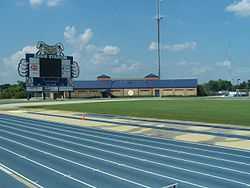Aggie Stadium (North Carolina A&T)
 | |
| Location |
Sullivan Street Greensboro, North Carolina 27405 |
|---|---|
| Coordinates | 36°4′53″N 79°46′13″W / 36.08139°N 79.77028°WCoordinates: 36°4′53″N 79°46′13″W / 36.08139°N 79.77028°W |
| Owner | NC A&T State University |
| Operator | NC A&T State University |
| Capacity |
17,500 (1981–1994) 21,500 (1995–present) |
| Record attendance | 34,769 (2001) |
| Surface | Natural Grass |
| Construction | |
| Broke ground | 1980 |
| Opened | September 12, 1981[1] |
| Renovated | 2011 |
| Expanded | 1995 |
| Construction cost |
$2.5 million ($6.49 million in 2015 dollars[2]) $4.5 Million (2011 Renovation) ($4.72 million in 2015 dollars[2])[3] |
| Architect |
Jason H. Jones, AIA Clark-Nexsen (2011 Renovation) |
| General contractor |
J.H. Allen Construction Company[4] Kenbridge Construction Company (2011 Renovation) |
| Tenants | |
|
North Carolina A&T Aggies football (NCAA) (1981-present) NC A&T State Aggies Men's Track & Field (NCAA) (1981-present) NC A&T State Aggies Women's Track & Field (NCAA) (1981-present) | |
The Aggie Stadium is a 21,500-seat multi-purpose stadium in Greensboro, North Carolina.[5] W. Edward Jenkins, a North Carolina A&T State University alumnus and architect, designed the stadium. Opened in 1981, the stadium is also the home of the new Irwin Belk Olympic class track. In addition Aggie Stadium features the state-of-the-art Joseph and Kathleen Bryan Fitness and Wellness Center. This 25,000 square feet (2,300 m2) fitness facility sits behind the scoreboard in the Northeastern Corner of Aggie Stadium.
Within the past decade, Aggie stadium has undergone renovations including the installation of lights, new sprinkler and drainage systems, and the reconditioning of the playing surface. In the Fall of 2005, Aggie Stadium unveiled Aggievision, a video scoreboard, commonly referred to as a jumbotron. Currently, the old pressbox is being demolished and replaced with a 10,000sqft pressbox complete with luxury suites. Aggie Stadium is home to the North Carolina A&T State University Aggies football team.
History
Before the construction of Aggie Stadium, North Carolina A&T Aggies played their home football games at Greensboro’s War Memorial Stadium, which was home to the nearby minor league baseball franchise. The university saw a great need to have an on campus stadium that could hold the growing number of fans attending home football games.
Aggie Stadium was designed by architect W. Edward Jenkins, a North Carolina A&T alumnus, and was constructed at a cost of more than $2.5 million. The stadium opened in 1981 and the first game played there was on September 12, 1981 against rival Winston Salem State University to an overflow crowd of more than 23,000 fans.[6]
To date, the largest single game attendance at Aggie Stadium was set in 2001 when 34,769 people were in attendance for a football game against the rattlers of Florida A&M University
Expansion & Improvements

The original plans for the stadium called for a seating capacity of 20,000 people, but due to the increased cost of materials, the plan was scaled back to 17,500.[4] For the first 14 years of operation, Aggie stadium’s permanent seating capacity stood at 17,500. However, in 1995 the stadium underwent a major expansion in which 5,000 additional seats were added in the south end zone area to complete the current horseshoe shape and raise the seating capacity to over 21,000. In 1999 a donation by the Ford Motor Company allowed for the construction of stadium lights for night games and an electronic marquee outside the stadium grounds.
In 2001, the university opened the Joseph and Kathleen Bryan Fitness and Wellness Center behind the stadium’s northeast end zone. Three years later, the Irwin Belk Track was finally completed. The facility is named after the former president of Belk Department Stores and a major financial contributor to the project. the Mondo Super X Performance track features eight 48-inch lanes and wide turns.[7]
In 2005, a digital scoreboard in the north endzone was added to Aggie Stadium. The scoreboard measures at approximately 66 feet high and 48 feet wide. the scoreboard also is equipped with a 23-foot video screen and sound system.
The most recent addition to Aggie Stadium is a 10,000 sq ft Sky Box complete with a Chancellor's Suite, facilities for press and coaches, as well as leasable luxury suites. The project was designed by Jason H. Jones, AIA, with Clark Nexsen's Charlotte Office, and was completed in April in time for the 2012 Football season.
Non Football Events
- International Friendship & Freedom Games (2009, 2010)[8]
- Mid-Eastern Athletic Conference Outdoor Track and Field Championships (2008–Present)[8]
- Murray Neely Invitational (2009-2010)[8]
- NCAA Division I Track and Field Championships - East Regional (2006, 2009–Present)[8]
- NCHSAA Track and Field Championships (2005–present)[8]
- New Balance Outdoor Nationals (formerly the Nike Outdoor Nationals) (2005–Present)[8]
- Russell E. Blunt East Coast Invitational (2004–2005)[8]
- State Games of North Carolina (2007)[8]
- USATF National Junior Olympic Track & Field Championships (2006–Present)[8]
Photo gallery
-
_Pressbox_2012-1.jpg)
West End Entrance and Press Box Exterior.
-

West End Interior and Press Box.
-

East Side Interior and Track.
-

The "Aggievision" Scoreboard in the North endzone of Aggie Stadium.
-

The Joseph and Kathleen Bryan Fitness and Wellness Center.
References
- ↑ http://cfreference.net/cfr/school/north-carolina-at/1503/1981;jsessionid=EDF2350F9023A81E3E71230F42C789DB
- ↑ 2.0 2.1 Consumer Price Index (estimate) 1800–2014. Federal Reserve Bank of Minneapolis. Retrieved February 27, 2014.
- ↑ "'After eight long months, the wait is over'". NC A&T State University Register. April 18, 2012. Retrieved January 2, 2014.
- ↑ 4.0 4.1 "Construction on Stadium Underway After Delays". A&T Register. 15 February 1980. Retrieved 31 March 2014.
- ↑ Holloway, Brian (2006). 2006 NC A&T Football. North Carolina A&T Athletics. p. 73.
- ↑ Blue Death Valley: The History of Aggie Stadium
- ↑ Collegeovals.com
- ↑ 8.0 8.1 8.2 8.3 8.4 8.5 8.6 8.7 8.8 Aggie Stadium MileSplit.us profile
http://www.ncatregister.com/thescore/foo....1a4bcf6878.html
External links
- Aggie Stadium - website
| Preceded by War Memorial Stadium |
Home of the North Carolina A&T Aggies 1981 – present |
Succeeded by Current |
| ||||||||||||||||||||||||||
| ||||||||||||||||||||||||||||||||||||||||||||
| ||||||||||||||||||||||||||||||||||||||||||||||||||||||||||||||||||||||
| ||||||||||||||
